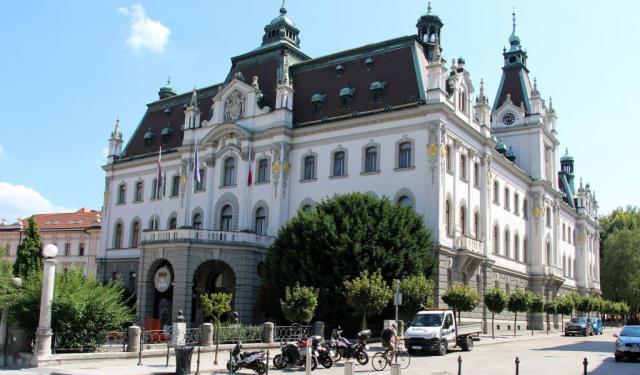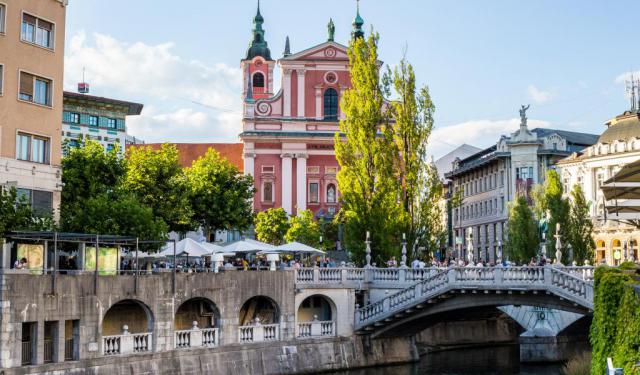
Stolnica svetega Nikolaja (Ljubljana Cathedral), Ljubljana (must see)
Initially constructed in the Romanesque style during the 13th century, Saint Nicholas' Cathedral saw numerous renovations before being ravaged by fire in 1469. Its rebirth commenced in the early 18th century, with a complete transformation guided by the vision of the Italian painter and architect Andrea Pozzo. Frescoes by Giulio Quaglio, sculptures by Angelo Putti, and altars by Paolo and Giuseppe Groppelli breathed new life into the edifice, with Francesco Robba contributing an altar in the left transept adorned with angels. This marked the beginning of Ljubljana's Baroque era, setting the tone for the architectural evolution of the city.
The cathedral is recognizable by its octagonal dome crowning its eastern side, while two bell towers grace the western side, adorned with gilded apples containing various relics and inscriptions. These towers, completed in 1705–06, house six bells, including the second oldest one in Slovenia, dating back to 1326. The facades are decorated with niches housing statues of bishops and saints, Baroque frescoes, and ancient Roman tombstones. Other notable features include a side entrance adorned with a Gothic pietà and a sundial dating back to 1826, bearing a poignant Latin motto: "Nescitis diem neque horam" ("You don't know the day or the hour").
In 1996, bronze sculptured doors were installed to commemorate Christianity's 1250th anniversary in Slovenia and the visit of Pope John Paul II. The Slovene Door depicts the country's history, while the Ljubljana Door is decorated with portraits of 20th-century bishops.
Inside, much of the original Baroque splendor remains, including frescoes in the cupola depicting the Holy Spirit and angels, along with depictions of the coronation of the Virgin and the glorification of Saint Nicholas on the dome walls, surrounded by celestial beings.
The cathedral is recognizable by its octagonal dome crowning its eastern side, while two bell towers grace the western side, adorned with gilded apples containing various relics and inscriptions. These towers, completed in 1705–06, house six bells, including the second oldest one in Slovenia, dating back to 1326. The facades are decorated with niches housing statues of bishops and saints, Baroque frescoes, and ancient Roman tombstones. Other notable features include a side entrance adorned with a Gothic pietà and a sundial dating back to 1826, bearing a poignant Latin motto: "Nescitis diem neque horam" ("You don't know the day or the hour").
In 1996, bronze sculptured doors were installed to commemorate Christianity's 1250th anniversary in Slovenia and the visit of Pope John Paul II. The Slovene Door depicts the country's history, while the Ljubljana Door is decorated with portraits of 20th-century bishops.
Inside, much of the original Baroque splendor remains, including frescoes in the cupola depicting the Holy Spirit and angels, along with depictions of the coronation of the Virgin and the glorification of Saint Nicholas on the dome walls, surrounded by celestial beings.
Want to visit this sight? Check out these Self-Guided Walking Tours in Ljubljana. Alternatively, you can download the mobile app "GPSmyCity: Walks in 1K+ Cities" from Apple App Store or Google Play Store. The app turns your mobile device to a personal tour guide and it works offline, so no data plan is needed when traveling abroad.
Stolnica svetega Nikolaja (Ljubljana Cathedral) on Map
Sight Name: Stolnica svetega Nikolaja (Ljubljana Cathedral)
Sight Location: Ljubljana, Slovenia (See walking tours in Ljubljana)
Sight Type: Religious
Guide(s) Containing This Sight:
Sight Location: Ljubljana, Slovenia (See walking tours in Ljubljana)
Sight Type: Religious
Guide(s) Containing This Sight:
Walking Tours in Ljubljana, Slovenia
Create Your Own Walk in Ljubljana
Creating your own self-guided walk in Ljubljana is easy and fun. Choose the city attractions that you want to see and a walk route map will be created just for you. You can even set your hotel as the start point of the walk.
Historic Buildings Walking Tour
The Slovenian capital has no shortage of historical buildings. The architectural wealth of Ljubljana accumulated over the years received a significant boost in the early 20th century thanks to the famous Slovenian architect, Joze Plecnik, a classicist, who tried to model the city on ancient Athens.
Among the notable local landmarks is the Ljubljana Central Pharmacy, a testament to the... view more
Tour Duration: 2 Hour(s)
Travel Distance: 2.8 Km or 1.7 Miles
Among the notable local landmarks is the Ljubljana Central Pharmacy, a testament to the... view more
Tour Duration: 2 Hour(s)
Travel Distance: 2.8 Km or 1.7 Miles
Ljubljana Introduction Walking Tour
Ljubljana is the capital and the heart of Slovenia. Being the country's cultural and political center, it is also Slovenia's largest city and has a long, storied past.
The exact origin of its name is not clear. Some linguists suggest that it may be rooted in "Ljubija," the original name of the Ljubljanica River derived from the Old Slavic male name "Ljubovid,"... view more
Tour Duration: 2 Hour(s)
Travel Distance: 2.0 Km or 1.2 Miles
The exact origin of its name is not clear. Some linguists suggest that it may be rooted in "Ljubija," the original name of the Ljubljanica River derived from the Old Slavic male name "Ljubovid,"... view more
Tour Duration: 2 Hour(s)
Travel Distance: 2.0 Km or 1.2 Miles


